THANK YOU!
YOUR PURCHASE OF THESE BOOKS SUPPORTS THE WEB SITES THAT BRING TO YOU THE HISTORY BEHIND OLD AIRFIELD REGISTERS
Your copy of the Davis-Monthan Airfield Register 1925-1936 with all the pilots' signatures and helpful cross-references to pilots and their aircraft is available at the link. 375 pages with black & white photographs and extensive tables
---o0o---
The Congress of Ghosts (available as eBook) is an anniversary celebration for 2010. It is an historical biography, that celebrates the 5th year online of www.dmairfield.org and the 10th year of effort on the project dedicated to analyze and exhibit the history embodied in the Register of the Davis-Monthan Airfield, Tucson, AZ. This book includes over thirty people, aircraft and events that swirled through Tucson between 1925 and 1936. It includes across 277 pages previously unpublished photographs and texts, and facsimiles of personal letters, diaries and military orders. Order your copy at the link.
---o0o---
Military Aircraft of the Davis Monthan Register 1925-1936 is available at the link. This book describes and illustrates with black & white photographs the majority of military aircraft that landed at the Davis-Monthan Airfield between 1925 and 1936. The book includes biographies of some of the pilots who flew the aircraft to Tucson as well as extensive listings of all the pilots and airplanes. Use this FORM to order a copy signed by the author, while supplies last.
---o0o---
Art Goebel's Own Story by Art Goebel (edited by G.W. Hyatt) is written in language that expands for us his life as a Golden Age aviation entrepreneur, who used his aviation exploits to build a business around his passion. Available as a free download at the link.
---o0o---
Winners' Viewpoints: The Great 1927 Trans-Pacific Dole Race (available as eBook) is available at the link. This book describes and illustrates with black & white photographs the majority of military aircraft that landed at the Davis-Monthan Airfield between 1925 and 1936. The book includes biographies of some of the pilots who flew the aircraft to Tucson as well as extensive listings of all the pilots and airplanes. Use this FORM to order a copy signed by the author, while supplies last.
---o0o---
Clover Field: The first Century of Aviation in the Golden State (available in paperback) With the 100th anniversary in 2017 of the use of Clover Field as a place to land aircraft in Santa Monica, this book celebrates that use by exploring some of the people and aircraft that made the airport great. 281 pages, black & white photographs.
---o0o---
YOU CAN HELP
I'm looking for information and photographs of pilot Halsey and his airplane to include on this page. If you have some you'd like to share, please click this FORM to contact me.
---o0o---
Thanks to Guest Editor Bob Woodling for help researching this page.
SPONSORED LINKS
HELP KEEP THESE WEB SITES ONLINE
FOR YOUR CONVENIENCE
You may NOW donate via PAYPAL by clicking the "Donate" icon below and using your credit card. You may use your card or your PAYPAL account. You are not required to have a PAYPAL account to donate.
When your donation clears the PAYPAL system, a certified receipt from Delta Mike Airfield, Inc. will be emailed to you for your tax purposes.
---o0o---
GEORGE E. HALSEY
George Halsey landed once, probably twice, at Parks Airport. His first landing was on May 29, 1929 as a competitor in the Gardner Trophy Race qualifying heat (he placed 3rd in heat 2) from Denver, CO to East St. Louis. Although he did not sign his name in the Register, we know from the history books that he was flying the Rearwin Ken-Royce he identified as NX44E. A Web site celebrating Rearwin aircraft is at the link.
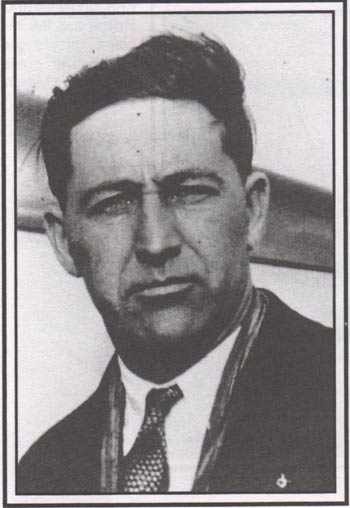 |
|---|
Halsey's airplane was a model 2000-C with Curtiss Challenger engine. George was a Rearwin company pilot demonstrating NX44E as a racer in the Gardner event within a month after it first flew. Based at Salina, KS, he identified his destination as St. Louis. Coincidentally, some years back your Webmaster made the most memorable cross-wind landing and takeoff at Salina on his way to California.
Photograph, right, is from this REFERENCE, page 47. There, NX44E is identified as the fastest of the Ken-Royce line, due to the installation of the Challenger engine. In that book we learn that NX44E was the prototype for the Ken-Royce line of Rearwins.
Halsey's second landing at Parks was on Thursday, September 5, 1929. He cited neither home base, destination, or whether he carried passengers. He identified his airplane as NR591H, another Rearwin 2000-C.
The online service of the Salina Journal had this to say about the Rearwin company and George Halsey, "A considerably more successful aircraft manufacturer that started in Salina was Rearwin Airplanes. Rae A. Rearwin founded the company in June 1928, a year after Charles Lindbergh flew the Spirit of St. Louis across the Atlantic. Rearwin's sons were named Ken and Royce. Notably, Ken Rearwin flew into the Davis-Monthan Airfield Monday October 7, 1935 at 6:30PM. He flew an unidentified Rearwin Sportster.
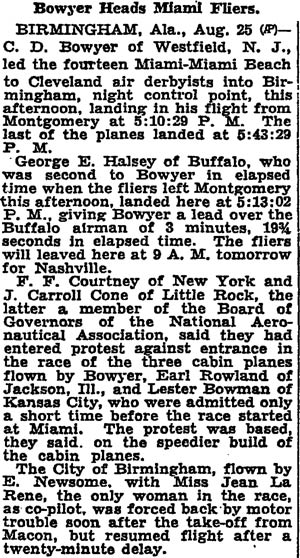 |
|---|
"Ken-Royce, the first Salina-built airplane, made its initial flight into the air at the municipal airport Sunday shortly before noon," the Salina Journal reported on Feb. 25, 1929. "(Pilot George) Halsey, after completing the trial flight, pronounced the plane to be one of the best in which he had ever flown, with indications that it will be one of the speediest commercial planes to be put on the market, as well as one of the best looking, its design having in mind a beauty of appearance as well as perfect aviation."
Later that year, Halsey competed in the National Air Races (NAR) August 24-September 4, 1929. The New York Times on August 26th, left, documents his flights to victory in the NAR Miami to Cleveland Derby. He placed first in the Class C race in 12:42:04, about 15 minutes ahead of his nearest competitor. He won $1,200 for his effort.
Notice mention of Earl Rowland, who also competed with Halsey in the Gardner Trophy Race linked above. Note, too, Les Bowman, who is a fellow signer of the Parks Airport Register, as is Jean LaRene.
While Halsey is cited in several articles in The New York Times, his Web presence is practically nil, with only one or two hits related to his participation in the 1929 NAR. There are records citing a "George E. Halsey" as a lieutenant in the Army Air Corp during WWII, but I cannot determine if that is our George E. Halsey. He is probably Halsey's son (see below).
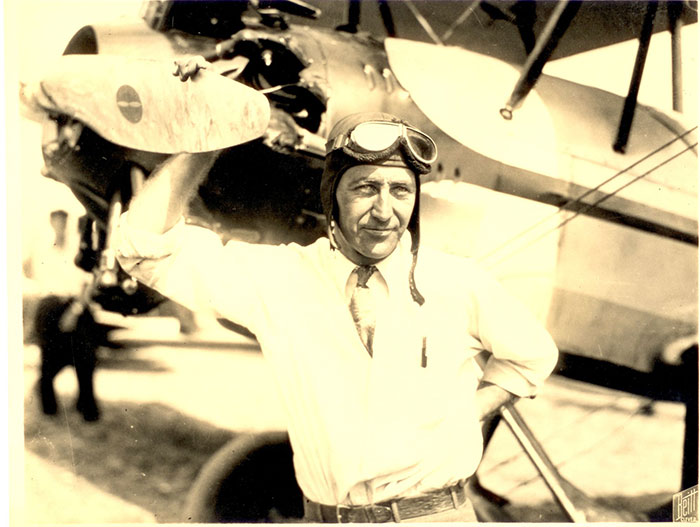 |
Above, Halsey appears next to what looks like a Rearwin ship. Note his belt buckle moved off to the side of his pants. This was a common feature of aviator belts, in order to prevent paint scratches when leaning against an airplane.
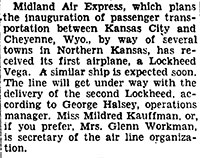 |
George Halsey was born January 16, 1897 in Culver township, KS a full six years before the first airplane flew in the hands of the Wright brothers. According to the 1900 census, he was living with his parents Franklin and Nellie in Culver. His father was in the hardware and implements business. Twenty years later, at the 1920 census, he was living at the YMCA in Salina, KS employed as a salesman in ahardware store.
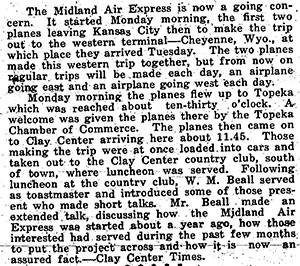 |
About 1921 he married Opal L. Todd in Salina, KS. About a year later, on August 25, 1922, their son, George Edward Halsey, Jr. was born. Halsey, Jr. would late become Colonel Halsey, USAF. They moved from Salina to Kansas City, KS and in 1931 he became the operations manager for Midland Air Express (news articles left and right) a small airline using Lockheed Vega Model 5 NC891E and another Vega, NC195E.
He moved to Dallas, TX and was living there in 1935. According to the 1940 census he was living with his family in Inglewood, CA, Opal, George, Jr. Donald, Frances, and Ruth. Another son, Frank, was born in 1940. George, Sr. was a mechanic in an aircraft factory. He died in 1968.
George Halsey, Sr. died April 27, 1968 in Los Angeles, CA. Wife Opal died September 1, 1970, age 71, at Inglewood, CA. Son George, Jr. passed away April 7, 1997 at at his home in Lompoc, CA.
---o0o---
SPONSORED LINKS
THIS PAGE UPLOADED: 06/18/13 REVISED: 01/17/14
